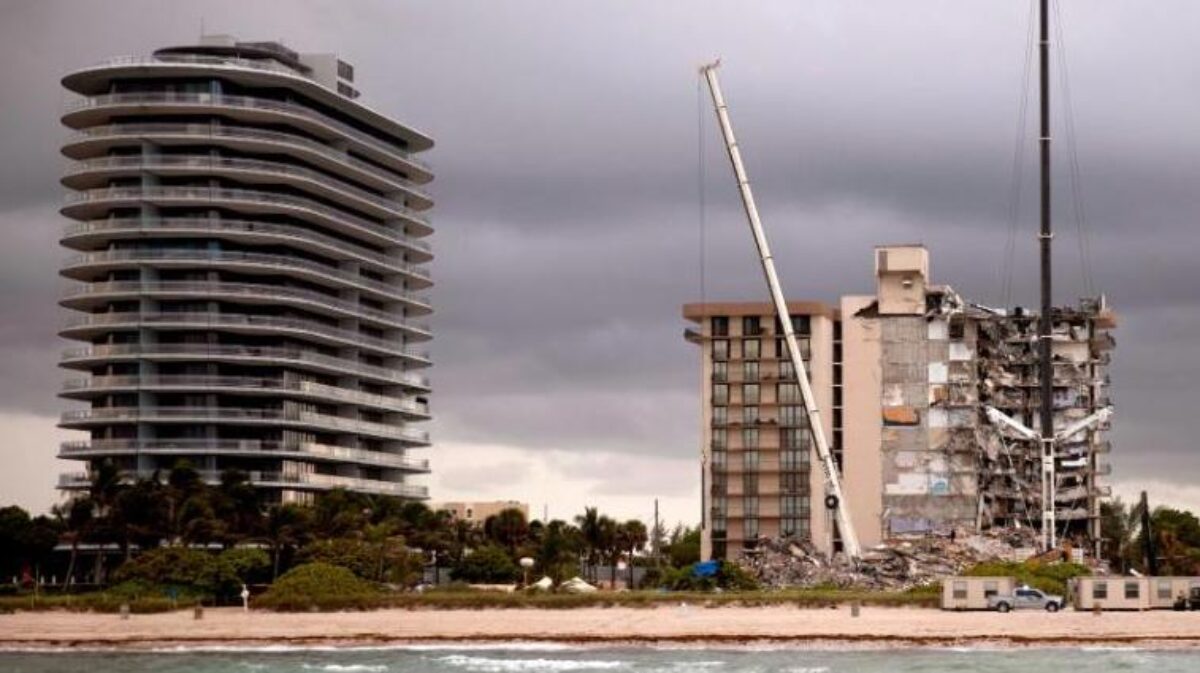On Thursday, the partial collapse of a residential building in Surfside, Florida, left 11 dead and 150 still unaccounted for. While we await answers about what caused this tragedy, we are left asking the question: What could cause a building to simply fall down?

The answer, usually: exceptional circumstances. In modern times and in developed countries, where buildings and other structures are well designed and a lot of checks are undertaken during the design and construction stages, the cause of failure can often be complex and multifaceted. It bears repeating that we won’t know the reason behind this particular building’s collapse, but, speaking generally, a single reason for structural failure is uncommon.
It is also worth recognizing that advances in technologies—structural theories and calculations—have extended our knowledge of architecture and engineering and reduced the failures. These advancements have allowed us to make exceptionally strong materials and develop a capacity to understand their limitations, a vast improvement on empirical building methods of ancient times.
So, while these types of building collapses are tragic, they are also relatively rare in buildings that utilize new innovations. Still, even just 40 years ago, the exchange of essential information from design to construction relied heavily on the human hand, increasing the risk of mistakes; today the use of computer aided production and communications has rapidly improved the safety with which we exchange information and build (though this, of course, does not negate the need for qualified designers and competent constructors deployed in all construction projects).
When buildings do collapse, however, it is sometimes due to unusual external forces—such as wind, earthquakes, gas explosions, fires, hurricanes, unpredictable snow and ice accumulation or impact that exceed the assumed loads which the structure was designed for. In these circumstance it’s not hard to understand why a building might fall.
But other general causes can be less obvious. Unsuitable ground conditions below the structure, for instance, can pose a threat to the integrity of a building. All structures are supported by soils or rock of different capacity and strengths. These are not immune to failure in themselves, often caused by heavy storms, earthquakes, climate change and other environmental events. This can cause a building’s foundation to fail slowly (like the tilting Tower of Pisa) or without warning, bringing down the structure.
Poor workmanship and badly constructed buildings, or the use of deleterious materials that do not comply with what was specified in the design, can also be a cause of failure. This can arise from undeliberate incompetence, but in rare cases can be considered criminal negligence.
In the last several decades we have also seen the impact of chemical changes in materials that can cause local failure initially and then large-scale failures that, over time, render buildings unsafe. Rusting steel expands six or seven times its original shape and when embedded in concrete it can expand and weaken the structure of a building.
So, with the possibility of unforeseen events, or structural issues that are invisible to the untrained eye, how can we be sure our buildings are safe?
All structures are designed with code safety factors that have been developed over decades and with much care to ensure a certain amount of safety and tolerance for accidental loads or poor workmanship. If a building is up to code, it is generally deemed safe.
Unusual structural failures have provided better understanding of how we design and construct, and have even changed codes of practice in some cases. Once such example is what is commonly known as progressive collapse or chain reaction when a small part of a structure fails but transfers its load (often weight in case of towers) to the next part of the structure. As the load aggregates, it becomes too much for the remaining structure to bear and a catastrophic collapse of the whole system takes place.
The 1968 collapse of Ronan Point, a 22-story tower in the UK, is an early example of a progressive collapse. It led to a root and branch review of the cause, changes in codes of practice and the discovery of many buildings that had to be strengthened to prevent repetition of such a catastrophe. While Ronan point did not collapse in its entirety, the failure gave birth to the term progressive collapse of whole or large parts of the structure. As a result, today engineers throughout the world design with some redundancy—that is to carry loads by more than one mechanism to guarantee that if one part of the structure fails the loads will redistribute safely to other parts of the system to prevent a progressive collapse.
Though building codes have evolved to better guard against collapse, when structural failures are first noticed, its paramount that test are undertaken, and proper remote and timely monitoring actions are put in place to check for such things as crack propagations. It’s also good practice to undertake non-destructive surveys, chemical tests and sometimes even small destructive tests to establish the nature and scale of the problem. Such actions require expertise, but tenants must bring issues to the attention of authorities and owners when they see warning signs; such as large cracks in the structure, fragmenting of material, vibration of floors and walls, or excessive changes in shape of the structure.
It is not uncommon to undertake surveys when property is purchased, but it’s less common to survey a property that has been in the same possession for a long time.
With the economic costs of new technologies such as drones, which can examine the elements of a building that were once inaccessible, structures that are showing distress or are above a certain age should be examined as a matter of course to prevent as best as we can more failure and tragic loss of life.
So, while we can’t yet ascribe a cause to the tragedy in Miami, we can learn a lesson in building safety. Designers, builders, owners and tenants must all be vigilant and investigate the root cause of structural issues when they arise and more readily survey their properties to ensure that buildings that were once safe, remain safe.
Hanif Kara is a professor of the practice of architectural technology at the Harvard Graduate School of Design and the cofounder and design-director of the interdisciplinary engineering practice AKT II in London. He is a member of the UK’s National Infrastructure Commission Design Group and was previously appointed to the UK Design Council’s Commission of Architecture and Build Environment.
This opinion piece originally appeared on CNN, posted June 29, 2021. Courtesy CNN.
